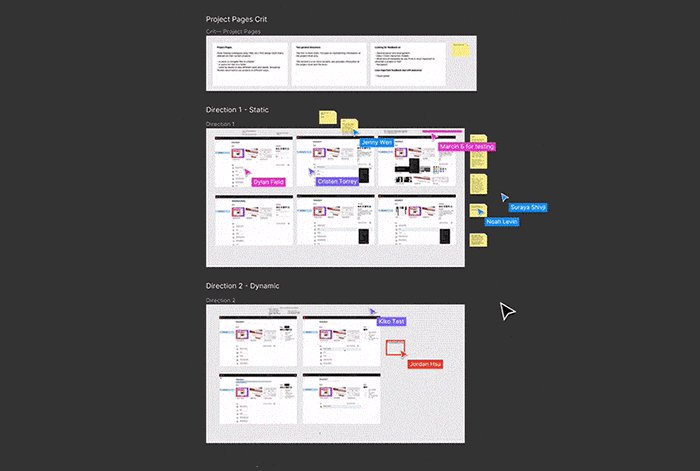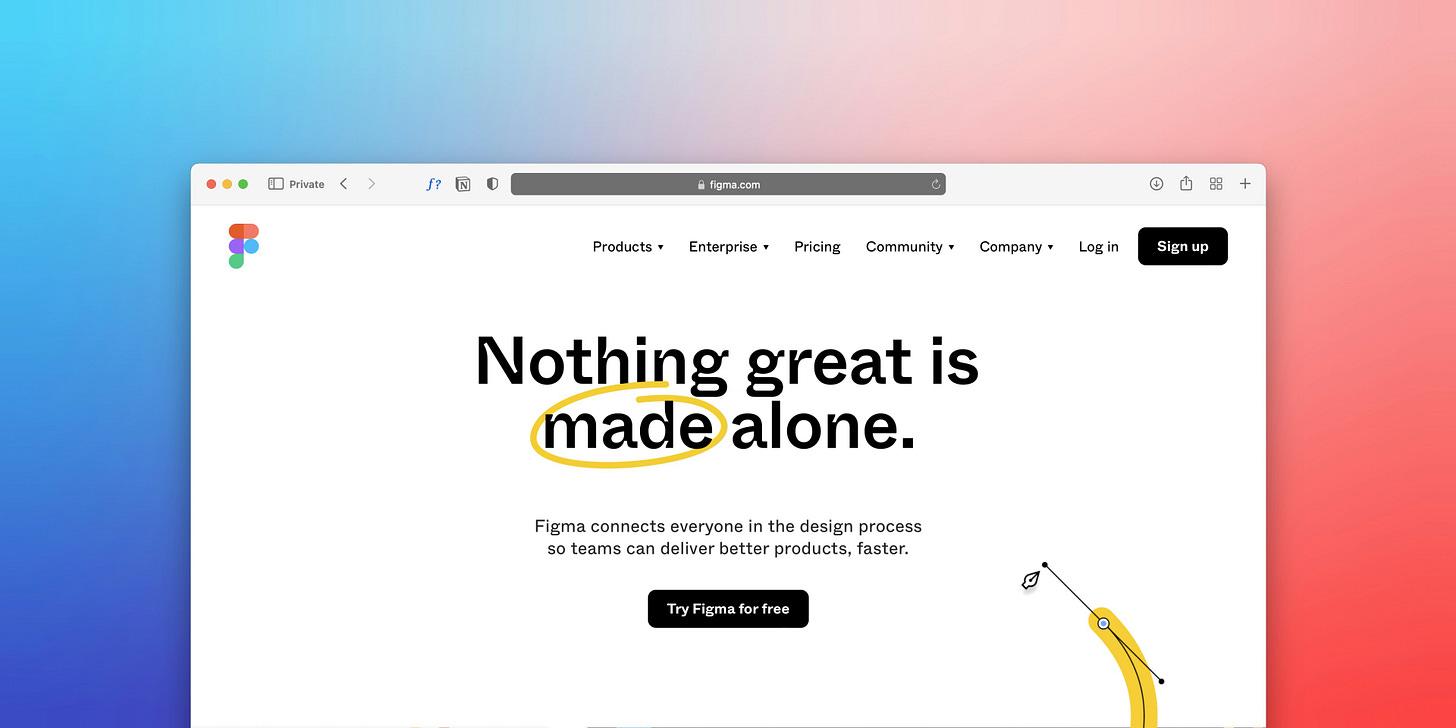What I learned working at Figma Pt 2: Prioritising craft
Craft was something everyone cared about deeply at Figma and I’ve been thinking a lot about how to build that same energy in future teams.
Joining the small(ish), early team at Figma in 2021 was incredible, and the vibes for the first couple of years were especially memorable. There was this unspoken agreement that craft mattered. Everyone, from PMs to engineers to designers, took serious pride in their work. But no one took themselves too seriously. It was confident without ego. People wanted to do great work and genuinely cared.
Most had come from companies where craft was a priority; places like Dropbox, Spotify, and Apple. Teams that, at least at one point, valued taste, detail, and delight. That mindset was already baked in. And when that’s the baseline, it lifts everyone. Even folks who came from less craft-focused environments levelled up quickly. Standards were high, but in a way that felt energising rather than overwhelming.
This quickly became the norm for me, but since leaving Figma it’s made me reflect on how amazing that time was. How did we foster the dynamic where craft isn’t just encouraged, but expected? And what can I do to build that kind of culture on in teams I join in the future?
Here are a few patterns I noticed at Figma that I believe made all the difference
Low ego, high care
The best people I worked with truly cared about quality, but didn’t get defensive when given feedback. There was a shared understanding that no one was defined by their work. So critique was welcomed and asked for, not avoided. You could share something rough and trust the team to help shape it into something better. That openness wasn’t just allowed, it was expected.
You could say things like “I don’t love this” or “something feels off here” and people would lean in. They’d ask questions, offer thoughts, and help riff on new ideas. That kind of honesty only works when there’s trust, psychological safety, and a shared commitment to the work over individual opinions.
Collaboration from day one
Design, product, and engineering were involved together from the very start. No sharp handoffs. No rigid roles. Just constant collaboration.
Everyone pitched in. Everyone gave feedback. Everyone shared ownership of the outcome.
The strongest solutions usually came from teams who were building on each other’s thinking, not from one person going off on their own, working in silo, in a private Figma file in their drafts, then sharing it with folk ‘when it is ready’. (I’ll share more about how amazing collaboration was at Figma in a few weeks).
Drawing inspiration from everywhere
We were always sharing things we loved. Screenshots, animations, and slick UI details we saw on Twitter, Instagram, and elsewhere. If something caught our eye, we’d drop it in Slack, explain what made it great, and chat about how we could bring similar energy into our own work.
It created a culture of shared taste. A steady rhythm of inspiration. And a reminder that the little things, the details, the delight, really do matter.
Feedback baked into the process
Critique wasn’t an afterthought. It was baked into how we worked, at every stage.
Product crits happened early. We’d bring half-formed ideas, rough problem statements, or early mocks and get input from cross-functional PMs. It wasn’t about getting a green light, just making the work better, and levelling up each others thinking.
Design crits happened repeatedly. Sometimes they were with your pillar or team when deeper context was needed, sometimes they were broader with the full team. Importantly, it wasn’t just designers giving feedback. PMs and engineers were in the room too, helping everyone improve, build shared context, and give feedback on potential blind spots.
Engineering crits happened early in every project. This gave space for engineers crit designs early, call out tricky edge cases, and give feedback on the finer details. It also helped designers and PMs develop a deeper understanding of how things would come to life, and listen to ideas from eng on how to make things feel even better.
These rhythms made feedback feel normal and low-stakes. By the time something launched, it had already been shaped by dozens of conversations, multiple teams, and by a lot of different roles.

Reviews as workshops, not approvals
The best exec reviews weren’t one way presentations looking for a green light. They were working sessions. You’d show up with a new feature, a strategy, or an idea you wanted to get feedback on. Not a final design spec you just wanted to ship.
That created a totally different energy. Leaders felt like collaborators. You could bring your best thinking, even if it wasn’t fully dialled in. And landing a meeting was rarely make or break for a project.
Launches could wait
We often delayed launches—not because we were behind, but because we weren’t quite proud of it yet.
It was normal to push a date back if it meant improving something. We’d take an extra week to tighten up an interaction, rethink copy, or sharpen UI details. Not because any one thing would make or break it, but because the combined effect of those details mattered.
If you want to see this mindset in action, watch the UI3 talk from Config. It’s a great example of craft at every level.
Details mattered to everyone
The attention to detail didn’t just come from designers. Engineers would obsess over interactions and riff with designers throughout the whole process. PMs would push for better copy. The whole team cared. That’s when things really shine, when everyone sweats the details together.
And while most people won’t notice each individual thing, they feel it. The product just feels better, even if they can’t explain why.
Listening to users, continuously
We were constantly listening to users; on Twitter, in support tickets, in community forums. Not just to fix bugs, but to pay attention to what frustrated people, what they loved, and what they expected from the product.
It helped us build empathy, spot patterns early, and avoid repeating the same mistakes. We didn’t just fix things, we learned from them.
What it all adds up to
Over time, this kind of environment built three things:
1. Low ego and high trust
People cared deeply about quality but welcomed input. There was a shared belief that feedback made the work better. And that created psychological safety to take risks and grow.
2. Seamless, ongoing collaboration
Cross-functional work happened naturally. People were in each other’s files, riffing on ideas, sharing thoughts early, and constantly learning from one another.
3. Process designed for quality
Regular feedback. Room to slow down when needed. And a culture where people invested in the details wasn’t just encouraged. It was expected.
What we can do to bring this to our teams
Open up design crits
Bring PMs and engineers into your design reviews. Let them see how designers think. Help them develop their own taste and appreciation for the craft, and encourage them to contribute their own critiques!
Hire for humility and collaboration
Look for people who love feedback. People who want to riff together. Then make it normal to work in each other’s files, riffing on things together, and share thinking early and often.
Don’t ship if it’s not ready
If something doesn’t feel good enough, push the timeline. Show your team and your leadership why spending a bit more time will lead to a better product and more impact.
Prioritising craft isn’t just about taste. It’s about creating the space, rituals, and expectations that let great work happen again and again. It takes intention, but when you get it right, the results are worth it.




Love this way of thinking, and I agree, all of the detail and care is what helps to create something that *feels* good, not just something that works well or looks good 👏🏻
"Low ego and high trust" is my favorite 🥹